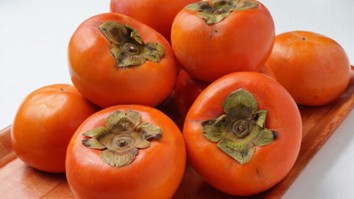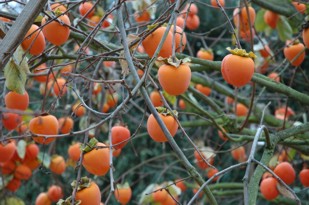| Perennial / Desiduous Trees / PERSIMMON TREE Diospyros Fruit Seeds |
|
|
|
|
| |
|
Plant name - Persimmon
|

|
|
 |
|
 |
| Common name - Diospyros
|
| Plant type - Desiduous |
| Vegetation type -
Perennial |
| Growth rate - Medium |
| Leaf / Flower color
- Green / Pink |
| Other names - Diospyros Virginiana
|
| |
| Description : |
Persimmons are the edible fruit of a number of species of trees in the genus Diospyros.
Diospyros is in the family Ebenaceae. The most widely cultivated species is the Asian persimmon, Diospyros kaki.
In color the ripe fruit of the cultivated strains range from light yellow-orange to dark red-orange depending on the species and variety.
They similarly vary in size from 1.5 to 9 cm (0.5 to 4 in) in diameter, and in shape the varieties may be spherical, acorn-, or pumpkin-shaped.
The calyx generally remains attached to the fruit after harvesting, but becomes easy to remove once the fruit is ripe.
The ripe fruit has a high glucose content. The protein content is low, but it has a balanced protein profile. Persimmon fruits have been put to various medicinal and chemical uses.
Like the tomato, persimmons are not popularly considered to be berries, but in terms of botanical morphology the fruit is in fact a berry.
.
|
| |
| Growing Instructions : |
* Fill a bowl with one or two handfuls of fine-milled peat moss. Water the peat until it's evenly moist, mixing it with your hands so all the peat is dampened evenly. Begin the process in late summer or fall so the seeds have time to germinate and grow sufficiently for late spring or summer transplanting.
* Mix the persimmon seeds with the damp peat in the bowl. Transfer the peat and seed mixture to a zip-top bag. Press out the air and seal the bag closed. Label the bag with the contents and date. Prepare up to twice as many seeds as trees desired, as persimmon germination rate can vary between 50 and 90 percent, depending on growing conditions.
* Store the bag in a 35 to 40 degree Fahrenheit location, such as a refrigerator. Check the moisture in the medium and mix in additional water to keep it moist as necessary. Keep the seeds refrigerated for 60 to 90 days to emulate natural winter stratification processes that force persimmon seeds out of dormancy. Some seeds may germinate during refrigeration, which indicates the seeds are ready for planting.
* Fill 5-inch diameter pots with moist potting soil. Use pots with bottom drainage holes. Set the pots in a drip tray to catch any excess water as it drains.
* Sow one persimmon seed per pot, planting the seeds about 1-inch deep in the soil. Place the pots in an area with full, all day sunlight where temperatures remain between 68 and 86 degrees F. Mist the soil surface to ensure it's evenly damp and cover the pots with clear plastic to retain the moisture during germination.
* Remove the plastic when the seeds germinate, which can take up to two weeks. Continue to water the seedlings when the soil surface dries so the soil remains moist but doesn't become soggy, and provide the plants with full, all-day sunlight.
* Dig a planting hole the same depth as the seedling pot in the prepared site, once the persimmon seedling is about 12 inches tall. Slide the persimmon out of the pot, keeping most of the potting medium intact around the root ball, and plant it in the hole so it's at the same depth it was previously growing.
|
| |
|
|
|
|
|
